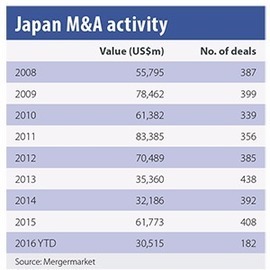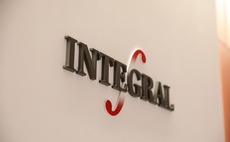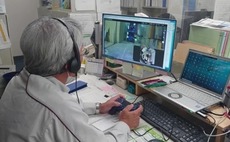
Japan's middle market: Simmering prosperity

GPs are finding opportunity in Japan’s economic stagnancy and dramatic demographic trends, but embracing this massive market will require a sharper focus on planning, as well as patience and poise
When Longreach Group acquired Wendy's Japan earlier this month, the deal coincided with some of Japan's gloomiest macroeconomic headlines in recent memory. The firm recognized, however, that unlike almost every other Asian market, the private equity opportunity in this sphere of activity is not based on long-term growth and modernization patterns.
In this case, the opening came in the form of a globally recognized restaurant brand that was struggling to proliferate beyond a single outlet in Tokyo. The Wendy's Japan takeover will leverage a related hamburger chain acquisition, First Kitchen, in order to provide an in-house springboard for expansion without the burden of sourcing new locations in a prohibitively expensive real estate market.
At the same time, the large-cap end of corporate Japan was dominating investor attention with reports of financial struggles at names such as Toshiba, Sanyo and Sharp, the latter of which was recently bailed out by Taiwan's Foxconn after a string of heavy annual losses. Foreign investors, which account for some 60% of the Tokyo Stock Exchange, have taken notice, and with one eye on a strengthening yen, have sold down more than 40% of their holdings on Japan's Nikkei index so far this year.
The Longreach transaction, meanwhile, typifies a number of PE's key inroads in this environment, including the increasing potential to acquire a non-core asset like First Kitchen from a traditionally risk-wary owner like Suntory Holdings. But perhaps more importantly, it illustrates that despite the media noise around crumbling conglomerates and equity sell-offs, Japan's silent majority of mid-market survivors offers a deep well of prospective deals with bolt-on growth and strategic exit possibilities.

"Most people know Japan from the Toyotas and Panasonics, but if you add up all these large caps, there are only about 10,000 of them and there are 3.8 million small to medium-sized enterprises [SMEs]," says Jun Tsusaka, managing partner at investment firm Nippon Sangyo Suishin Kiko (NSSK). "There's a whole pool of companies that people don't read about in The Financial Times and The Wall Street Journal that are out there, and when you have 3.8 million fish, you're going to find some juicy catches."
Bleak picture
Hopes for a strong resurgence in Japan after the global financial crisis have been dampened by locally specific factors including the 2011 Great East Japan earthquake and a 2014 recession connected to a dramatic sales tax hike. The plausibility of PE success in this context, however, is being shaped by a growing consensus that the economic malaise is more disappointing than disastrous.
In the past five years, Japanese GDP has warbled between anaemic year-on-year growth of around 1.5% and subtle retreats of less than 1%. This uneasy balance reflects a mixed performance record for Prime Minister Shinzo Abe's so-called Abenomics program, which has been credited with the strongest labor market in two decades and a rapidly growing tourism industry despite broader shortcomings in mitigating deflationary pressures.
"Although the government's goal hasn't been achieved, Japan's attractiveness has arguably improved, compared to the pre-Abenomics period," says Alicia Garcia-Herrero, chief economist for Asia Pacific at Natixis. "Nevertheless, because of low improvement in productivity, wage growth is expected to stagnate, which increases difficulties for the government to achieve the policy goal."
Compared to other markets in the region, Japan has not performed well over the last 12 months in terms of private equity investment, according to AVCJ Research. The $3.5 billion committed in 2015 represents a 55% drop versus the 2010-2014 average, despite a 27% increase in deal volume.
From the local GP perspective, however, the stagnancy reflects a resilience where less diversified or more debt-laden economies may have buckled into depression. The resulting backdrop is a surprisingly fertile environment for cutting deals - as long as proactive value-add plans are integrated into strategies that don't depend on macroeconomic growth.
"Ironically, if the Japan macroeconomic outlook was very bright, and the pressures on companies therefore eased, that actually would be adverse to deal flow. Conversely, if Japan was doing terribly, that would be adverse as well," observes Mark Chiba, group chairman and partner at Longreach. "But we're in a spot now where Japan in a macro sense is just idling along, so the structural pressures for restructuring businesses and reconfiguring for global growth really are able to drive deal opportunities."
Data from Mergermarket suggest an equilibrium between falling PE activity and rising strategic activity. Annual M&A volumes have risen steadily since a two-year slowdown in the wake of the global financial crisis, with 2016 poised to see the highest level of activity in four years by capital committed.
"The pipeline over the last 12-18 months and what we're seeing in the pipeline today continue to be some of the best deals we've seen in the bigger 20-year picture," says Richard Folsom, co-founder of Japan-focused buyout firm Advantage Partners. "Japanese corporates have record amounts of cash right now and are probably as acquisitive as they've ever been, both domestically and internationally, so it has created a very robust exit environment for us as well."
While increased acquisition interest from strategic players has enhanced exit options, it has also tightened an already competitive deal sourcing environment. This scenario is characterized by longstanding rivalries between well-financed corporations, which often leave PE firms few options other than trying to leverage non-price advantages as relatively neutral players.
For firms such as Unison Capital, finding opportunities has largely been a matter of maintaining a positive reputation through existing portfolio connections and being ready to embrace companies that have special requirements via exclusive negotiations. "One thing that we want to avoid is to walk into a very widely held full-fledged auction, where basically money matters and nothing else," says Tatsuo Kawasaki, co-founder at Unison. "We want to be in a position where the seller needs a bit of quiet discussion because they have a need beyond maximizing the price per share."
PE has otherwise attempted to stand out from the pack by offering more flexible transaction terms and synergies related to investee companies. But although these inputs remain credible, experiential incentives, the economic tides related to an aging and shrinking domestic customer base have intensified the impetus among rival corporates to defend market share through M&A.
"There is a lot of local appetite for acquisitions but there are not many attractive targets in the large cap market," says Ryo Okubo, a PE-focused partner at law firm Nagashima Ohno & Tsunematsu. "When there's a good large cap deal, every PE firm and every company rushes in to bid. I have seen more than 10 companies and firms in the same bidding process, so it's very competitive and the bid price tends to become difficult for PE funds."
This setting is further aggravated by a high level of liquidity in the market. Although local banks have traditionally contributed to PE deal sourcing by matching firms with companies, the positive impact of this role has been diminished by the institutions' need to put capital to work in an environment of low interest rates and a low cost of financing.
"Companies that might otherwise have needed to appeal to financial sponsorship with a PE fund are now increasingly able to get additional credit from banks," says Paul Ford, a partner with KPMG in Japan. "Although we continue to see some situations where banks have refused credit to troubled companies which made them more amenable to a financial sponsor transaction, the pressure to accept a PE solution has been lessened to some degree."
Succession issues
Higher bank debt availability has also been driven by an increased urgency to safeguard regional economies within Japan where locally critical companies are having succession problems. According to official data, the average SME owner is now 60, and about two-thirds of this group are considered to have no succession plan in place.
While the aging of Japan's corporate leadership has been a popular talking point for at least a decade, the issue has only begun to pick up noticeably in the past two years to the point where it now represents the country's predominant deal flow driver. This evolution lends a certain advantage to private equity firms seeking proprietary deals since many succession-sourced transactions are likely to be too small for a competitive bidding process.
"Most of the M&A transactions that take place in Japan are SMEs with motivations driven by founder-owned privately held companies that have succession issues," NSSK's Tsusaka explains. "Someone hits a certain age and it really doesn't matter what's going on with the global economy, the Japanese economy or the currency. Basically, 80% of our transactions are coming from this phenomenon, which results in proprietary transactions that are attractively priced to generate attractive returns over different economic cycles."
As much as succession has disrupted deal flow in Japan, it remains a one-by-one sourcing channel with long timeframes related to relationship building, personal hang-ups and emotional decision making. The corporate carve-outs that represent PE's second best opportunity in the country, however, benefit from drivers with potential to deliver a more sustainable stream of activity. These factors include Japanese companies' need to expand globally, increased shareholder pressure to shed assets due to stricter governance rules, and a tendency among Japanese companies to be more diversified than their Western counterparts.
"As economic pressures get greater, you could see a breaking point for the corporate market, a point where it's just untenable for Japanese companies to hold onto these businesses," says David Gross-Loh, a managing director at Bain Capital Private Equity. "A few companies start doing it and then there is a significant wave of activity - that's conceivable in a way that is probably not going to happen in the founder market."
Adding value as these potential deals come into focus is a question of cementing a strategic rationale that is supported by earnings improvements through operational efficiencies or topline growth. While topline growth may be realized through international expansion or moving into adjacent markets in any jurisdiction, the opportunity is particularly compelling in Japan given the local sector's traditional hesitancy to follow this route.
"Mid-cap GPs in Japan should pay more attention to roll-ups and add-ons, which GPs in the US place at the center of their value creation strategies rather than organic growth," says Joji Takeuchi, co-head for private and alternative investments at Mizuho Asset Management. "Japan's GPs have really been focusing on streamlining the efficiency of management - and they should continue to do so - but M&A is increasingly in the minds of corporations in Japan and should provide some interesting opportunities."
The most pressing incentive to expand market share through roll-ups in Japan is arguably the consumer base trajectory, which is shaped by a rapid national population retreat. Current projections have the headcount failing by about 33% to 86 million people by 2060. In this context, private equity investors are logically drawn toward nursing care and senior lifestyle deals, which target the nation's wealthiest demographic and one of few in the country that is actually growing.
Investments targeting seniors benefit from the fragmented nature of the nursing home and drug store industries as well as the inroads associated with the growing popularity of at-home nursing services. As the over-60 age block reaches 40% of the population over the next 35 years, it is also expected to create new niche markets in internet-enabled consumer segments where PE firms have already established a substantial presence such as travel, nutrition, beauty products and entertainment.
Be the bridge
The most important impact of Japan's aging population, however, may not be the enlargement of any particular consumer market, but the shifting of business environment dynamics caused by labor dislocation and new corporate leadership that is not as closely tied to incumbent business models. In combination with pressure to expand into new markets, this development establishes an environment where PE's existing M&A execution machine can act as a bridge to facilitate cross-border deals.
Demand for such introductory and deal making services leverages Japan's historical reputation as a difficult market to penetrate. But while this cultural influence can represent an opportunity for PE, it remains the sector's strongest headwind in the country.
"Japanese companies tend to move pretty gradually and think with very long-term horizons," says Bain's Gross-Loh. "They have their approaches and systems and ways of doing things, and there tends to be a risk aversion and a level of consensus in decision making required to make big decisions that you don't see in other places. Those are the biggest obstacles that we're up against."
The conservative business culture in Japan has underpinned a longstanding skepticism about PE which, although warming up deal by deal over the years, remains a palpable barrier. While high-profile transactions such as the acquisitions of Panasonic Healthcare and Bushu Pharmaceuticals by KKR and Baring Private Equity Asia, respectively, continue to establish the asset class and pave the way for deals such as Longreach-Suntory, firms are advised to emphasize diplomacy in their approach strategies.
"As a general market story, it's more accepted than it was 5-10 years ago, but there are still sensitivities here that may not be as prevalent in other, more purely commercial markets," KPMG's Ford says. "Those sensitivities are going to remain because they're emotional rather than rational, but it will continue to move toward other markets where PE is seen as an entirely acceptable exit or partnering route."
Latest News
Asian GPs slow implementation of ESG policies - survey
Asia-based private equity firms are assigning more dedicated resources to environment, social, and governance (ESG) programmes, but policy changes have slowed in the past 12 months, in part due to concerns raised internally and by LPs, according to a...
Singapore fintech start-up LXA gets $10m seed round
New Enterprise Associates (NEA) has led a USD 10m seed round for Singapore’s LXA, a financial technology start-up launched by a former Asia senior executive at The Blackstone Group.
India's InCred announces $60m round, claims unicorn status
Indian non-bank lender InCred Financial Services said it has received INR 5bn (USD 60m) at a valuation of at least USD 1bn from unnamed investors including “a global private equity fund.”
Insight leads $50m round for Australia's Roller
Insight Partners has led a USD 50m round for Australia’s Roller, a venue management software provider specializing in family fun parks.








